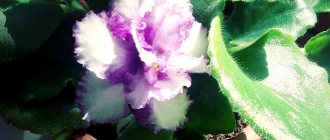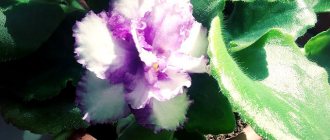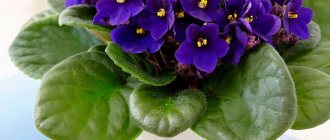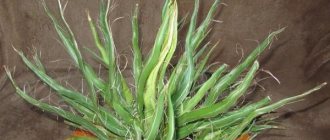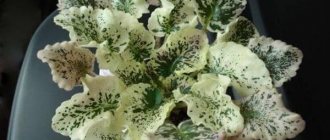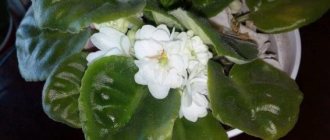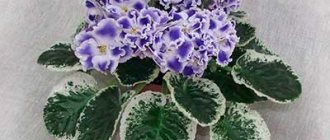An indoor violet can live quite a long time , turning into a rather unsightly bush with a bare trunk and a “cap” of greenery. Some species of flower growers who do not pay attention to their Saintpaulias live for 15-30 years.
Unfortunately, the main value of the violet, which lies in its flowering, ceases to exist without rejuvenating procedures - it simply does not bloom. With proper and timely “rejuvenation” of the rosette and proper care, Saintpaulia is practically immortal.
How to rejuvenate a mini violet?
How to rejuvenate violet
in different ways: By adding soil to young plants (by digging).
Re-rooting the socket. ... Adding soil
- Break off or trim the lower leaves.
- Sprinkle the bare stem with a nutrient layer of soil.
- Carefully level the poured soil.
Interesting materials:
How to cancel Xiaomi update? How to cancel payment for YouTube premium? How to cancel a sent email? How to cancel a paid subscription on Facebook? How do I cancel my EA Play subscription? How to cancel your ESO Plus ps4 subscription? How to cancel your boom subscription? How to cancel your Apple Music mts subscription? How to unsubscribe from Facebook? How to cancel a subscription on Samsung?
Favorable conditions for the life of Saintpaulia
How long violets live at home depends primarily on the conditions of their maintenance.
Conditions favorable to the full development and growth of violets, in terms of the parameters and quality of the growing air space: temperature, humidity, etc., are also favorable for humans.
Violets feel great at home.
Therefore, no special growing conditions are required. If a person is comfortable, then she will be comfortable too.
Bright flower bed on the windowsill
The extensive violet family is a perennial herbaceous plant with evergreen foliage. Plants mature quickly, reaching a height of 10-20 cm. The stem is formed from the leaves of the basal rosette. The leaves are round in shape, pointed towards the edge. They are dense, leathery, covered with soft hairs. The leaf blades of violets come in various shades of green, and in some varieties they are spotted. Buds with five petals, wide range of colors: pink, blue, purple, two-tone. Saintpaulia flowers are simple or double. The plant loves long-term but diffused lighting, warmth (20-25°C), and air humidity of 60-70%.
Violet - interior decoration
Methods for propagating violets
You can expand your collection of indoor flowers using several propagation methods:
- leaf;
- stepson (daughter rosette);
- seeds.
Stepchildren are shoots that appear in the axils of the leaves. They are removed to maintain a decorative appearance. The stepson, which has 4-5 leaves, is cut off and rooted in a separate pot.
Breeders prefer to grow Saintpaulias from seeds. The seeds are germinated in loose, moistened soil placed in a container. Greenhouse conditions are created for them. After 15-21 days, leaves appear on the seedlings, they are picked and transplanted into separate containers.
Feeding for a long life
As such, there is no recipe for fertilizers for longevity. Throughout all periods of cultivation, Saintpaulia must receive the required amount of nutrients and microelements. Moreover, the NPK ratio varies during different periods of growth and vegetation.
While the plant is young, it is fed according to this ratio, depending on the growing season. In the senile state, the emphasis is on phosphorus and potassium, not forgetting about nitrogen fertilizers for gaining leaf mass.
After flowering, replanting usually follows and there is no point in fertilizing , since the new soil has a supply of necessary nutrients.
What characteristics of a variety affect longevity?
To answer this question, you need to define the concept of “longevity”. Longevity of what? If in general plants, then varietal characteristics do not have a very strong effect on life expectancy.
If we take into account the period of active development and flowering, then there are certain features of care, conditions, and reproduction for each variety. The rules for caring for different types of violets are especially
With normal care, Saintpaulia can live for half a century , but turn into a rather unsightly plant, more reminiscent of a palm tree with a long trunk and a head of greenery.
Among the varietal characteristics that most influence the lifespan of a flowering plant are:
- plant and flower size;
- color of petals and leaves;
- flower shape;
- flowering duration;
- resistance to burnout, diseases and pests;
- low maintenance requirements.
How many years can violets live with proper care?
Proper care, timely rejuvenation of the plant, and replanting make it possible to admire the beauty of violets for decades.
You should not rush to throw away your pet; with great desire, time and life-saving rejuvenation procedures, it will delight you with its flowering more than once.
Of course, any plant ages over the years. An attentive florist must have noticed that periodically the violet parted with its lower, worn-out leaves.
The phenomenon is quite normal, except that if certain procedures are not followed, then after 1-1.5 years there will be no rosette, and instead an unpresentable palm tree will appear. By carrying out rejuvenation at least once every two years, the life of the violet is extended by decades.
Varieties and names of Uzambara violets
Saintpaulia has long been used in indoor floriculture, and to date many varieties of this plant have been developed. Most of them are hybrids of Saintpaulia ionantha, as well as interspecific hybrids of Saintpaulia ionantha and some other Saintpaulia species (Saintpaulia magungensis, Saintpaulia comfusa).
Usambara violet Chimera
In floriculture, the general name Saintpaulia hybrida (Saintpaulia hybrida) is sometimes applied to all Saintpaulia hybrids.
Saintpaulia varieties are divided into several groups, primarily based on the color and shape of the flowers and their type. According to this principle, classic, star-shaped, fantasy, bordered Saintpaulias and “chimera” Saintpaulias are distinguished.
Based on the type of leaves, plants are primarily distinguished as “boys” and “girls”. The “girl” plants have a light spot on the upper side at the base of the leaf, while the “boy” varieties have completely green leaves.
The most common are Saintpaulias with rosettes, the diameter of which varies from 20 to 40 cm. There are giant varieties (diameter from 40 to 60 cm), miniatures (up to 15 cm) and even so-called microminiatures; in the latter plants the diameter of the rosettes is only about 6 cm.
Some varieties of Saintpaulia and photos
Blue Dragon
Blue Dragon
This plant has a strong and large rosette. The leaf blades have a uniform bright green color. There are cloves along the edge of the foliage; their underside is pale red. Semi-double flowers consist of lilac-blue petals, the edges of which are corrugated.
Midnight Frolik (Midnight Fun)
Midnight fun
This variegated plant has green foliage with whitish speckles. The loose rosette reaches about 0.4 m in diameter. The foliage is long-petioled. The bush begins to bloom for the first time only in the second or third year of growth. The flowers are lilac-purple.
Midnight Twist
Midnight Twist
The flowers of this variety are semi-double and corrugated. The edges of the petals are purple. Green leaves are monochromatic. The socket is dense and compact. The bush blooms very profusely and for a long time.
Kissing Bandit
Bandit's Kiss
Blue-purple flowers can be semi-double or double. A fully opened flower reaches about 60 mm in diameter. Dark green leaf blades have a glossy surface. The spreading rosette is quite large in size.
Harry Potter
Harry Potter
Green “quilted” leaf plates form a small compact rosette. Purple flowers have a whitish edge. The lifespan of one flower is approximately 8 weeks.
Cupidon (Cupid)
Cupid
Double light pink or white flowers have a lemon-greenish edge. The foliage is one color and has a slightly wavy edge. The outlet is very neat and large. This plant begins to bloom very early.
Breath Thunderstorms
Breath of the Storm
The flowers stand out in a very large size. Closer to the center, the petals are burgundy in color, and along the edges they are purple. Their edges are whitish and terry. It blooms for a long time, but not very luxuriantly. The slightly wavy leaf blades have a dark green color.
You can root a violet leaf directly in the ground.
From my experience I know that it is more convenient to plant planting material directly into the ground, there is less loss and time. To propagate in soil, place a leaf cutting of a violet without roots, cut side down, at an angle of 45 degrees or almost horizontally, placing the edge of the leaf on the side of the cup, lightly pressing the cutting with your finger and covering it with soil. The shallower the depth of planting of the cuttings, the faster the leaf will produce new rosettes.
Leaves planted without roots sometimes lose turgor, but there is no need to worry. As soon as roots appear, turgor will be restored. After some time, babies emerge from the ground.
If violet cuttings are planted in the summer, then they do not need to be covered, but if the apartment is cool, then it is better to cover the cuttings or young rosettes with a transparent bag. Be careful with watering so that the petiole does not rot; keep in a warm and bright place, but not in the sun, which can cause burns.
Rejuvenation - how to extend the life of a flower?
Violets, like any other houseplant, are a living biological organism that naturally undergoes the aging process. But these processes can be significantly shifted if you use the proper techniques for caring for such a capricious flower.
Over the years, and according to experienced collectors after 4 years , the violet loses its decorative effect. Buds appear less and less often, leaves become thinner, and the stem eventually becomes bare.
Without taking any measures, you can only watch how the appearance of a once beautiful plant deteriorates. Plus, a bare stem has a negative impact on the condition of the flower , inhibiting its growth and development, shredding the leaves, putting the plant into a “stupor”.
Old violet.
In this condition , replanting is not enough; rejuvenation of the entire plant is required. Experienced violet growers recommend the two most proven methods of rejuvenation.
Method 1
When the stem is bare no more than 4 cm and has not lost its green mass. The essence of the method is to move the flower into a new container with a new substrate and deepen the exposed stem.
Step by step process:
- the violet is removed from the container;
- the stem is cut off at the site of formation of the earthen coma;
- all fading and damaged leaves are removed;
- the plant is planted in a new container with new high-quality soil so that the stem is completely immersed in the soil;
- light watering is done to keep the soil slightly moist;
- Using a plastic bag creates a greenhouse effect so that there is a small space for air to enter.
Saintpaulia remains in this position for 10-12 days. Soil moisture is maintained by small waterings if necessary. Afterwards the greenhouse is removed. Further care is carried out in the usual way.
After some time, under favorable conditions for the plant, the stem will take root and the violet will begin to grow.
Method 2
Suitable for plants that have not been replanted for a long time, and the stem has aged significantly, become stale and has become dark brown. In this condition, it will not take root in the new soil.
In this case, another rejuvenation procedure is required:
- the violet is removed from the container;
- the stem is cut off at the beginning of the earthen clod;
- 6-8 leaves are left at the top, the rest are removed. It is necessary that the plant devote all its efforts not to feeding the green mass, but to the formation of roots;
- With a sharp instrument, the coarsened bark is removed from the stem to the green part;
- the bare section of the stem is lowered into a container of water (possibly with root formation stimulants). The water should be warm and changed every three days.
Violet rejuvenation.
Soon, roots will begin to appear on the bare part of the stem. When their length reaches at least 3 cm, the plant is ready to be transplanted into a container with substrate.
Recommendation! The rejuvenation process is best done in spring or autumn. In winter, at lower temperatures, violets may be dormant, and in the hot summer months there is a possibility of pests attacking a weakened plant.
Method 3
The use of this method is effective with a very elongated and bare trunk.
The essence of the method is to separate the upper part with a sharp instrument “in one go,” stripping the tip down to living tissue and placing it in a nutritious, high-quality substrate.
It’s a good idea to create a greenhouse effect with daily ventilation.
After about 2 weeks, the trunk will take root, the violet can be freed from the greenhouse and installed in a permanent place of residence.
By rejuvenating an indoor violet in these ways, we can say with confidence that with proper care it will delight with flowering for many years.
Features of the growth and development of Saintpaulia at home
There are main factors that influence proper growth, full development and harmonious long-term flowering and, ultimately, how many years indoor violets live:
- warm;
- water;
- air;
- nutrition.
Some varieties also require timely, correct formation.
Having a capricious character, the indoor violet is very sensitive to non-compliance with these basic factors that affect the full development, growth and flowering, which subsequently affects its longevity.
Growing Saintpaulia at home is enough:
- observe the temperature regime;
- required air humidity;
Optimal temperature and humidity are the basis for successfully growing violets.
- sufficient amount of light;
- carry out proper watering;
- provide the plant with good nutritious soil.
Plus, maintain these requirements every day and we can say with confidence that the Uzambara violet will delight the gardener with its flowering beauty for many years.
Important! Knowledge of the physiological and biological characteristics of the variety, daily care and attention to Saintpaulia is a guarantee of proper growth, development and harmonious “cap” long flowering for many years.
Separating and planting rosettes in separate pots.
You can separate the babies after the leaves are sufficiently grown and deep green in color. Transplant into a small pot or into separate cups. At the bottom you need to put drainage in the form of expanded clay or foam. Everything is covered with soil, a depression of about 1 cm is made and a rosette of violets is planted.
Children should receive excellent lighting, warmth, and moderate watering. When the rosettes grow, it will be possible to “transfer” them to a pot, which should correspond in size to the plant. By following these simple requirements for propagating violets with leaves, you will get a beautiful plant that will delight you with beautiful and long flowering.
There is a method of cuttings, when the violet leaf is propagated directly in a transparent plastic bag.
Saintpaulists share their experience on how to propagate violets, when a rooting substrate is poured into a small bag, a cut of the cutting is inserted into the soil, the bag is tightly closed and simply hung on a rack. At the same time, make sure that the leaf blade does not rot from excess moisture, so it is often ventilated.
What to do if a variety gradually degenerates?
two different opinions regarding the degeneration of varietal characteristics : it degenerates after a certain time and not, if timely actions are taken.
Proper care will help to avoid the degeneration of the variety.
The majority of collectors refer to the experience and recommendations of B.M. Makuni. and T.N. The essence of their advice is timely rejuvenation of the plant, and rejuvenation with re-rooting of the top does not always give a positive result.
It is better to re-grow Saintpaulia from a leaf cutting, choosing the best specimens of the children. It is with this method that the violet variety does not degenerate.
Advice! The issue of variety degeneration is complex and is not always limited by instructions. Each variety, species or hybrid form has its own nuances and characteristics.
Diseases and pests of Saintpaulia
Violet is susceptible to attacks from both insects and various diseases. Only proper home care and prevention will help you keep the plant healthy and beautiful.
Insect pests
Mealybug on violets
Most often the plant is attacked by the following parasites:
- Mealybugs. A white cotton-like coating forms on the cuttings of the plant.
- Thrips. The flowers dry quickly and yellow dust forms on the leaves.
- Cyclamen mites. The young leaves curl up, and the adults have longer hairs.
- Nematodes. The roots of the plant are affected. The most dangerous type of pests, since their influence is not immediately noticeable, but only during transplantation. A plant infected with nematodes lags behind in development, blooms poorly, and young leaves grow ugly and curled.
If you find pests on your violets, take action immediately. Protect the sick plant from healthy ones and treat it with special preparations. After processing, it is recommended to wrap the violet in plastic for a couple of days.
Diseases
Gray rot on violets
Violets are susceptible to the following diseases:
- Powdery mildew is a fungal disease that is transmitted through fungal spores. It is expressed in a white coating on the leaves. Over time, the leaves on violets become deformed and die.
- Fusarium is a fungal disease that affects the root system of violets. The fungus rises through the vessels into the leaves of the plant. During the active phase of development, moist light brown spots appear on the leaves. The leaf cuttings begin to rot. Unfortunately, the plant cannot be saved. You should get rid of it as soon as possible.
- Gray rot is a disease that occurs when violets are grown at low temperatures. Appears in the form of brown spots with mold. The disease weakens the plant's rosette, liquefies the roots and cuttings. To save the plant, it is necessary to remove all leaves with signs of infection, preventing the infection from entering the soil.
Keep an eye on your plants, inspect them carefully once a week and respond immediately to any changes.
A healthy plant can resist diseases and will delight you with long and abundant flowering. Take a photo of Saintpaulia, share it with your friends, exchange leaves and expand your collection.
Sources and literature
Sources and literature
- Botany. Encyclopedia “All the Plants of the World”: Trans. from English = Botanica / ed. D. Grigoriev and others - M.: Könemann, 2006 (Russian edition). - P. 809. - 1020 p.
- Hessayon D. G. All about indoor plants = The House Plant Expert / Transl. from English O. I. Romanova. - M.: Kladez-Books, 2000. - P. 201-203. — 256 p. — 15,000 copies.
- Zalessky D. M. Saintpaulia: their wild species and cultural issues. - L.: Leningrad State University Publishing House, 1983. - 144 p.
- Ivanina L.I. Gesneriaceae family // Plant life: in 6 vols. T. 5. Part 2. Flowering plants / ed. A. L. Takhtadzhyan. - M.: Education, 1981. - P. 436-439.
- Uzambara violet // Snakes - Fidel. - M.: Soviet Encyclopedia, 1956. - P. 4. - (Great Soviet Encyclopedia: [in 51 volumes] / chief editor B. A. Vvedensky; 1949-1958, vol. 44).
- Description of Saintpaulia on the Wikipedia website ru.wikipedia.org.
